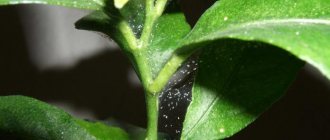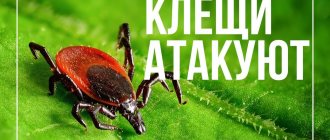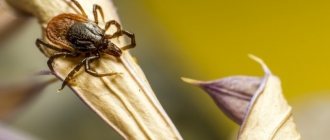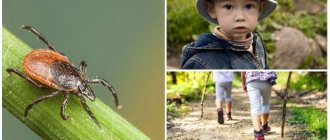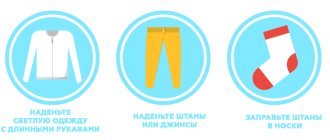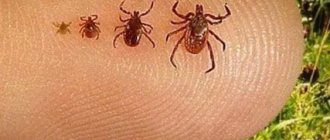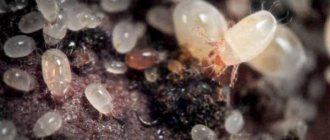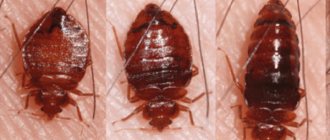The tick season in 2022 began ahead of schedule and the first victims went to emergency rooms at the end of March. The first ticks wake up and attach themselves to a person usually in mid-April; last year, the first cases of bites were also recorded in March, and these are not isolated cases, but the full beginning of the tick season. How is the situation now? Are ticks active and do they pose a threat to people and animals? Let's consider the main periods of activity of ixodid ticks and methods of protection against them.
What causes ticks to appear earlier?
One of the main misconceptions is that you can only suffer from a tick bite in the summer, in hot weather, while walking in the forest, mountainous areas, or steppe zones with tall grass. The insect population is rapidly spreading throughout populated areas. Pests live not only in natural conditions, but also in home environments.
Bloodsuckers begin to wake up when the night temperature reaches at least 1-3°C. Active life begins at a stable temperature of 10°C.
When ticks appear in Moscow depends on the stability of weather conditions. Early appearance of insects is provoked by sunny weather, warm wind, and lack of precipitation. Adults can be found after the snow melts and the air warms up well. In Moscow, the tick activity season begins at the end of March, beginning of April and ends in September with the onset of cold weather. If the spring is cold, with frosts, the population size will be insignificant until summer.
The appearance of ticks in Moscow 2021
According to Rospotrebnadzor statistics for the spring of 2022, more than 1,500 people suffered from tick bites in Moscow. People went to medical institutions with blood-sucking bites. Greatest aggressiveness
insects was recorded in May. In comparison with similar observations in 2022, this figure fell threefold, which is associated with more frequent measures to treat large areas and territories from insects.
In 2022, 21 cases of infection with infectious diseases after a bite were registered.
The following areas of Moscow and the Moscow region have fallen into the danger zones:
- Elk Island National Park;
- Izmailovo;
- Timiryazevsky Park;
- Serebryany Bor;
- Saltykovsky Park;
- Zelenograd administrative district.
The Rospotrebnadzor website provides detailed, regularly updated information about the early activity of pests, when ticks appear in the Moscow region and how to protect yourself and your pets from bites.
Is there a way to prevent encephalitis and borreliosis?
If you live in an area where encephalitis is endemic, you should get an encephalitis vaccine every 3 to 5 years. Vaccinations are provided free of charge at government centers.
In our clinics you can get vaccines: Encevir NEO and Klesch-E-VAK.
- Encevir NEO is a Russian-made vaccine for children against tick-borne encephalitis. Encevir NEO is an inactivated vaccine; it contains a sterile, purified, concentrated suspension of inactivated tick-borne encephalitis virus. Encevir NEO is recommended for children aged 3 to 17 years inclusive, living in areas where tick-borne encephalitis is endemic.
- Tick-E-VAK is a vaccine for the prevention of tick-borne encephalitis in children and adults. This is a domestic drug that appeared on the market in 2012. The vaccine is a suspension of killed tick-borne encephalitis virus. When vaccinating children from 1 to 16 years of age, a dose of 0.25 ml is used, for adults - 0.5 ml.
Those who are vaccinated for the first time need to administer the vaccine twice at intervals of 1-7 months (best after 5-7 months, for example, in the fall and spring).
However, in case of an epidemic, emergency vaccination is also carried out. In this case, the interval between the first and second vaccinations is two weeks.
After a year, revaccination is carried out, and the drug is administered only once. Subsequent revaccinations are carried out every three years, each time requiring only one administration.
Vaccination is carried out all year round, including during the epidemic season. However, you can go to the forest no earlier than two weeks after the second vaccination.
After a standard vaccination course of three vaccinations, immunity lasts for several years.
Unfortunately, there is no vaccine against borreliosis. It was developed, but manufacturers considered its production unprofitable. After a tick bite, you should try to deliver the removed tick to the laboratory for examination for the presence of Borrelia and the causative agent of encephalitis.
What danger comes from ticks?
Blood-sucking insects pose a direct threat to human health. Ticks are carriers of dangerous contagious infections. The penetration of an arthropod under the skin is invisible to humans. The bite does not cause pain or discomfort. This is due to the fact that the parasite’s saliva contains anesthetic substances. Therefore, a person may not always notice bite marks or the tick itself under the skin.
An infestation of ticks increases the risk of bites several times. What diseases are transmitted by arthropods:
- Epidemic encephalitis is the most dangerous, acute disease accompanied by inflammation of the brain and spinal cord;
- typhus - a sharp lesion of the central nervous system, heart muscle, the appearance of specific rashes on the body, the condition is accompanied by a persistent high temperature;
- Lyme disease (borreliosis) - an inflammatory-allergic reaction with severe headache, migraine, hot flashes, and the appearance of migratory erythema on the skin (bright red spots of different diameters);
- tularemia – an extreme degree of intoxication of the body with impaired cognitive activity, inflammation of large lymph nodes;
- hemorrhagic fever is an acute viral infection that damages arteries and veins, causing blood clots to form.
Among pets, ticks are more often found in dogs, since animals spend active walks outside every day. The bite of bloodsucking animals provokes such dangerous conditions in the animal’s body as partial or complete paralysis of the nervous system, coagulation of red blood cells, as a result of which the animal dies from oxygen deficiency. A dog’s reaction to a bite can be acute, when damage to the body develops rapidly, within 1-3 days. Also, viruses transmitted from ticks can be in a passive state. In such cases, the disease develops slowly, imperceptibly, gradually killing the pet’s body.
Symptoms of a tick bite
If there is an invasion of ticks and non-compliance with the rules of protection, the likelihood of a bite increases. The length of the incubation period after infection depends on the type of arthropod. Most often, the first signs of infection are skin rashes that appear within 24 hours. The presence of blood sucking inside the body, disruption of the functionality of internal organs may not manifest itself for a long time. Several months pass before the first symptoms appear.
Signs of a tick bite:
- severe or mild itching of the skin, redness at the site of the bite;
- swelling of the eyelids, discharge of serous fluid from the eyes;
- the presence of characteristic passages on the skin;
- increase in body temperature to subfebrile values;
- muscle and joint pain, body aches;
- over time, peeling of the scalp, eyebrows, eyelash loss;
- with infection of the urinary and reproductive system ─ itching, pain when urinating, vaginal discharge in women, lumbar pain, ulcers on the penis of men.
With tick-borne acariasis, an anaphylactic reaction may suddenly develop. Shortness of breath appears, the victim experiences a lack of air, pathological mucus accumulates in the respiratory tract, and the lumen of the bronchi narrows due to rapidly increasing swelling. Fever, suffocating cough, and chest pain develop. The condition is life-threatening.
Can repellents be used?
Applying repellents and acaricides to the body and clothing is an effective measure to repel ticks. However, you should be aware that the widely used repellent diethyltoluamide (DEET) is prohibited for use on the skin of children, as it can cause serious neurological complications if it gets into wounds. Permethrin-based repellents and insecticides only work on clothing and can kill ticks on contact.
However, when applied to the skin, permethrin (pyrethrin) is deactivated by reaction with skin oils and is rendered useless (despite manufacturers' instructions that it can be applied to the skin). Repellents based on picaridin (icaridin), which is intended for application only to clothing, are relatively safe for children over 6 months of age.
How to protect yourself from ticks
Sanitary services give clear recommendations on how to protect yourself from ticks in the countryside or in the forest. Before an upcoming walk in nature, it is recommended to wear clothes, shoes, and a hat to cover your body as much as possible. Periodically examine animals, children, and yourself. Ticks are easier to spot on light-colored clothing. If you are in the forest, tuck your pants into your socks and button up your shirt completely so that the collar fits snugly around your neck. Treat exposed areas of the body, as well as clothing, with repellent (a synthetic aerosol substance to repel arthropods). While walking, avoid bushes and tall grass.
An effective option for protecting dogs and cats from ticks is vaccination. Special collars, shampoos, drops, sprays that are applied to the fur and skin will help prevent bloodsucking bites.
The most effective method to protect people and animals is to treat the area against ticks with special acaricidal agents. Such events are mandatory for private organizations and public utilities.
What do preventive methods of combating the increase in the number of ticks and their spread include:
- disinsection of open areas and territories in accordance with sanitary requirements;
- timely collection of bulky garbage, food waste, prevention of the formation of spontaneous landfills near residential buildings, in courtyards, flower beds, and lawns;
- cleaning water bodies from pollution, plants, household waste;
- hydraulic engineering work - strengthening the coastline, cleaning the bottom;
- timely removal of food waste in sealed containers.
Habitats
Ticks prefer moderate humidity and no direct sunlight. Therefore, arachnids are most often found in deciduous and mixed forests, where they live in tall grass or dense undergrowth. However, ticks gradually occupy increasingly larger territories. In recent years, they can increasingly be found in summer cottages and city parks.
Ticks also settle on trees, but almost never rise to a height of more than 1.2 - 1.4 m. Most often, parasites take refuge under the bark or in cracks on the lower part of the trunk. Such shelter attracts arthropods even more if there is dense grass growth around the tree.
Cost of tick treatment
- Sites
- Houses and cottages
- Travel outside the Moscow Ring Road
| Plot area (acres) | Price per hundred square meters |
| to 10 | from 400 rub. |
| up to 20 | from 350 rub. |
| up to 40 | from 250 rub. |
| up to 50 | from 200 rub. |
| 1 ha | from 21,000 rub. |
| House area (m²) | Price (RUB/m²) |
| up to 100 | from 3500 rubles |
| 100 — 200 | 35 |
| 200 — 300 | 30 |
| 300 — 500 | from 20 |
| more than 500 | negotiable |
| Distance | Departure cost (rubles) |
| up to 20 km. | 500 |
| from 20 to 50 km. | 750 |
| from 50 to 80 km. | 1000 |
| from 80 to 100 km. | 1300 |
| from 100 km. | 1500 |
Types of treatment against ticks
Professional tick treatment services in Moscow and Moscow Region use two main methods - fumigation using cold and hot fog. Using special devices, the working solution of the acaricidal agent is sprayed over a certain area. Disinsection is carried out when there is a sharp increase in the population to destroy arthropods, as well as for preventive purposes to prevent uncontrolled reproduction of ticks.
Cold fog is the transformation of liquid into a fine aerosol. Suitable for treating small areas - flower beds, lawns, local areas, cottages.
Hot fog - the formation of smoke (steam) when the working solution is heated. The method is used to remove arthropods from fields, forests, and to disinfect large areas.
The sooner treatment against ticks is organized, the lower the statistics of cases of arthropod attacks. carries out tick treatment in Moscow and the surrounding Moscow region in one day. The effectiveness of the event is ensured by professional exterminators, the use of safe preparations, and innovative equipment.
Periods of activity
- Active reproduction of ticks begins in May-June, during the same period there is a sharp increase in cases of attacks on people. This is due to the fact that females consume more food during the breeding season. The parasites reach their maximum numbers from mid-May. This number of individuals remains until June if the weather remains warm, without sudden temperature fluctuations.
- The next peak in the increase in the number of tick individuals occurs at the end of August, coinciding with the mushroom season. After this, the ticks are depleted of nutrients that were in reserve, and the population of these arthropods declines.
- Ticks can be observed until September-October, but in smaller numbers. Depending on the weather, the extinction of the remaining individual individuals may continue until the end of October.
Myth. It is easy to remove a tick by pouring oil or gasoline on it.
In fact . It is better to remove the tick at the emergency room. But you can do it yourself. You should use tweezers or thread (but don’t use your bare hands, there is a risk of damaging the tick, and it will partially remain in the skin, causing suppuration). It is absolutely forbidden to pour oil, cologne or anything else on the tick - otherwise it will die and remain in the wound. The tick must be grabbed as close to the head (that is, to the skin) as possible and carefully, slowly twisted or pulled out of the wound. After removing the bloodsucker, it must be placed in a matchbox and taken for examination. And treat the wound with an antiseptic (and do this for several days until it heals).
Myth. Ticks jump from trees. You can become infected even while walking along the alleys of the park.
In fact . Ticks live near the ground and attack only from grass and small bushes. Therefore, if a person walks along a path without turning into the grass, he is not afraid of ticks. But sometimes owners can get ticks from their pets, from whose fur the ticks quickly run towards them. Climbing up the human body, ticks look for places convenient for suction. They often settle in the groin, under the arms, and on the neck. Therefore, upon returning from “risky” walks, it is important to completely undress and carefully examine yourself and your children, pets, and the clothes you have removed too.
